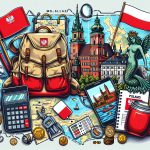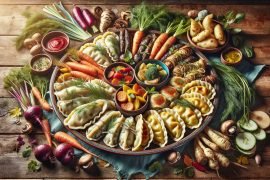
Visiting the cultural center to learn about Polish culture is an exciting experience. You get to try out different Polish foods that are full of flavors and have interesting stories behind them. There’s also traditional folk dancing that tells stories about Poland’s history. If you’re interested in learning more deeply, there are workshops on the Polish language and literature that give you a glimpse into what Polish society is all about. Plus, there are art and history exhibits that show important moments and achievements in Poland’s past.
Another great part of the experience is joining in on the community and holiday events. This isn’t just about watching from the sidelines; you actually get to be a part of Polish traditions. This makes you wonder, how does getting to know another culture like this help us understand our own identities and heritage, especially in a world where cultures are constantly mixing?
Traditional Polish Cuisine
Exploring traditional Polish cuisine introduces us to a world where food not only nourishes but also tells the rich history of Poland. The diversity in landscapes and historical influences in Poland has shaped a cuisine known for its variety and depth. For example, pierogi, which are dumplings filled with a range of ingredients from potatoes and cheese to fruits, and bigos, a stew made with sauerkraut and various meats, highlight how Poles make the most out of the ingredients available to them. These dishes showcase the skill of turning simple ingredients into something delicious and complex.
In traditional Polish cooking, there’s a strong emphasis on the balance of meats, grains, and vegetables, reflecting the people’s deep connection with their environment and the changing seasons. This balance ensures meals are both satisfying and nutritious, embodying the Polish approach to eating that values both taste and health.
As Polish cuisine continues to embrace modern influences, it does so in a way that respects its roots. The evolution of Polish food demonstrates an openness to new flavors and techniques while preserving the essence of traditional dishes. For instance, contemporary Polish chefs might experiment with the spices used in pierogi filling or present bigos in a more refined way, but the foundational recipes and ingredients remain unchanged.
For those interested in experiencing traditional Polish cuisine, starting with pierogi and bigos is a good idea. Not only do these dishes offer a taste of Poland’s culinary diversity, but they also provide insight into the country’s culture and history. With each bite, you can appreciate the layers of flavor and history that make Polish food truly unique.
In conversations about Polish cuisine, it’s clear that this is a food tradition that values both its past and its future. The careful blending of old and new, the dedication to local ingredients, and the celebration of seasonal eating are all aspects that make Polish food stand out. Whether you’re dining in Poland or trying your hand at Polish recipes at home, the experience is sure to be both enriching and delicious.
Folk Dancing Lessons
At the cultural center, you can dive into Polish culture through our folk dancing lessons. These aren’t your average dance classes. They’re a full-on journey into the heart of Poland’s history and traditions. You’ll move to the beat of music that has echoed through time, learning dances like the energetic Mazurka and the elegant Polonaise. Each dance tells a story – of community, the changing seasons, or significant historical moments. Whether you’re just starting or you’ve danced before, our lessons are tailored to challenge and delight you. You’ll walk away with a deeper connection to Polish heritage, thanks to our hands-on approach to teaching.
Let’s break it down further. When you join a class, you’ll start with the basics of a dance, say the Mazurka. It’s not just about the steps; it’s about understanding where the dance comes from. What’s the story behind it? How did it reflect the life of the people at the time? This context turns each lesson into a mini history lesson, making the dance more meaningful. As you progress, you’ll notice the differences between dances from various regions of Poland, each with its unique flair and significance.
The goal here is not just to teach you a set of movements but to immerse you in the Polish way of life, past and present. You’ll feel a part of something bigger – a tradition that has been passed down through generations. And don’t worry about keeping up. Our instructors are here to guide you every step of the way, ensuring you’re comfortable, challenged, and most importantly, having fun.
Language and Literature Workshops
Expanding on the cultural journey initiated with folk dancing, the cultural center introduces language and literature workshops aimed at enriching your connection to Polish heritage. These workshops welcome everyone, from beginners to those already familiar with Polish, offering a well-rounded educational experience.
In the language sessions, participants dive into the essentials of Polish communication. You’ll learn how to converse, understand the grammar, and get the pronunciation just right. This hands-on approach allows for a genuine interaction with Polish culture, making your learning experience both practical and enjoyable.
Turning to literature, we explore the incredible world of Polish stories and poems. Imagine discussing Adam Mickiewicz’s passionate verses or Wisława Szymborska’s insightful poems. These classes not only cover the writings of such influential authors but also the historical and philosophical contexts that influenced them. It’s like taking a journey through Poland’s heart and soul through its literature.
The workshops are not just about listening and taking notes. They’re interactive, encouraging discussions, and exercises that make you think critically about what you’ve learned. For example, you might analyze a poem by Szymborska and discuss its relevance to modern society, or practice your Polish by acting out a scene from a play. This approach makes the learning process engaging and deeply informative.
In essence, these workshops offer a unique opportunity to immerse yourself fully in Polish culture. By understanding the language and delving into the literature, you’re not just learning about Poland; you’re experiencing it. And who knows? This might just be the beginning of a lifelong passion for Polish culture.
Art and History Exhibitions
The cultural center showcases Polish heritage through its carefully chosen art and history exhibitions. These displays highlight Poland’s rich history and artistic development. For instance, you can see everything from the detailed work in traditional folk art to the impactful creations of the modernist era. Each artwork tells a story, offering a glimpse into Poland’s soul.
On the history side, the exhibitions provide a detailed look at Poland’s timeline, focusing on key events and figures that have played a role in shaping the country’s identity. This approach not only informs visitors but also connects them on a deeper level with Polish culture.
By selecting and organizing these exhibitions thoughtfully, the center ensures visitors get an engaging and educational experience. It’s not just about presenting art and history; it’s about making those subjects come alive. Visitors leave with a greater understanding and appreciation of what makes Poland unique.
For example, a visitor might encounter an exhibition on the Warsaw Uprising of 1944, which uses photographs, personal accounts, and artifacts to convey the event’s significance. This immersive experience doesn’t just recount facts; it helps people feel the resilience and spirit of the Polish people.
In adopting a more straightforward and engaging approach, the center makes Polish culture accessible to everyone. Whether you’re a history buff, an art enthusiast, or just curious, the exhibitions offer something of value. They’re a testament to Poland’s enduring legacy and a reminder of the power of culture to unite and inspire.
Community and Festive Events
The cultural center brings Polish culture to life through various community events and festivals. These activities are more than just fun; they help people connect with Polish traditions, deepening their understanding and appreciation. For example, folk dance performances showcase the rich stories of Poland through detailed dances and colorful costumes. They highlight the country’s history and regional diversity. Also, culinary festivals offer a chance to dive into Poland’s delicious food heritage, featuring dishes that are both traditional and innovative.
One of the key events is the Wigilia, or Christmas Eve feast, which is a highlight of the year. It brings families together, reflecting how people celebrate in Poland and strengthening the community’s cultural ties. The cultural center plans these events carefully, aiming to stimulate the senses, intellect, and emotions of attendees. This approach turns the center into a lively place for cultural exchange and learning.
In every event, the goal is to create an immersive cultural experience. By offering a mix of music, food, dance, and seasonal celebrations, the center provides a comprehensive look at Polish culture. It’s not just about observing; it’s about participating and feeling part of something bigger. This hands-on approach makes learning about culture both engaging and memorable.
Conclusion
Exploring Polish culture at the cultural center is truly an eye-opening experience. It gives everyone a chance to dive into Poland’s rich traditions in a fun and interactive way. You can try out delicious Polish dishes, learn a few steps of folk dancing, and even pick up some Polish language and literature.
There are also art and history exhibits that show off Poland’s past and present. Plus, the center organizes community gatherings and celebrations that bring people together, not just those from the Polish community but anyone interested in learning about new cultures. All these activities help keep Polish traditions alive and share them with others.
The cultural center does a great job at making Polish culture accessible and enjoyable for everyone.






Comments are closed.